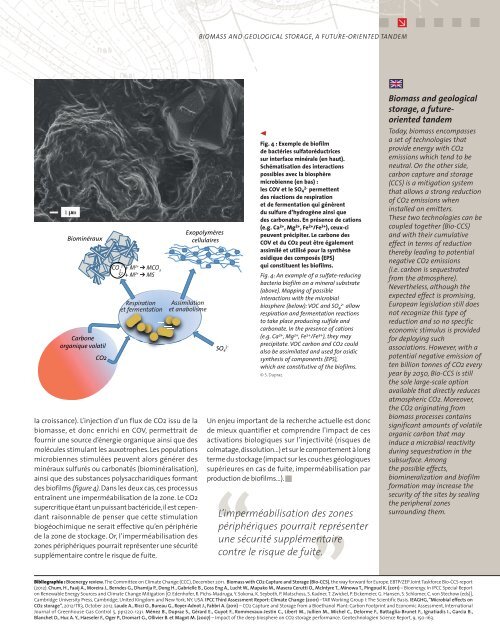revue_geosciences16
revue_geosciences16
revue_geosciences16
Create successful ePaper yourself
Turn your PDF publications into a flip-book with our unique Google optimized e-Paper software.
Biominéraux<br />
Carbone<br />
organique volatil<br />
CO2<br />
2- 2+ CO + M ➔ MCO3<br />
3<br />
S2- + M2+ ➔ MS<br />
Respiration<br />
et fermentation<br />
la croissance). L’injection d’un flux de CO2 issu de la<br />
biomasse, et donc enrichi en COV, permettrait de<br />
fournir une source d’énergie organique ainsi que des<br />
molécules stimulant les auxotrophes. Les populations<br />
microbiennes stimulées peuvent alors générer des<br />
minéraux sulfurés ou carbonatés (biominéralisation),<br />
ainsi que des substances polysaccharidiques formant<br />
des biofilms (figure 4). Dans les deux cas, ces processus<br />
entraînent une imperméabilisation de la zone. Le CO2<br />
supercritique étant un puissant bactéricide, il est cependant<br />
raisonnable de penser que cette stimulation<br />
biogéochimique ne serait effective qu’en périphérie<br />
de la zone de stockage. Or, l’imperméabilisation des<br />
zones périphériques pourrait représenter une sécurité<br />
supplémentaire contre le risque de fuite.<br />
biomass and geological storage, a future-oriented tandem<br />
Exopolymères<br />
cellulaires<br />
Assimilation<br />
et anabolisme<br />
SO 4 2-<br />
Fig. 4 : Exemple de biofilm<br />
de bactéries sulfatoréductrices<br />
sur interface minérale (en haut).<br />
Schématisation des interactions<br />
possibles avec la biosphère<br />
microbienne (en bas) :<br />
les COV et le SO 2-<br />
4 permettent<br />
des réactions de respiration<br />
et de fermentation qui génèrent<br />
du sulfure d’hydrogène ainsi que<br />
des carbonates. En présence de cations<br />
(e.g. Ca2+ , Mg2+ , Fe2+ /Fe3+ ), ceux-ci<br />
peuvent précipiter. Le carbone des<br />
COV et du CO2 peut être également<br />
assimilé et utilisé pour la synthèse<br />
osidique des composés (EPS)<br />
qui constituent les biofilms.<br />
Fig. 4: An example of a sulfate-reducing<br />
bacteria biofilm on a mineral substrate<br />
(above). Mapping of possible<br />
interactions with the microbial<br />
biosphere (below): VOC and SO 2-<br />
4 allow<br />
respiration and fermentation reactions<br />
to take place producing sulfide and<br />
carbonate. In the presence of cations<br />
(e.g. Ca2+ , Mg2+ , Fe2+ /Fe3+ ), they may<br />
precipitate. VOC carbon and CO2 could<br />
also be assimilated and used for osidic<br />
synthesis of components (EPS),<br />
which are constitutive of the biofilms.<br />
© S. Dupraz.<br />
Un enjeu important de la recherche actuelle est donc<br />
de mieux quantifier et comprendre l’impact de ces<br />
activations biologiques sur l’injectivité (risques de<br />
colmatage, dissolution…) et sur le comportement à long<br />
terme du stockage (impact sur les couches géologiques<br />
supérieures en cas de fuite, imperméabilisation par<br />
production de biofilms…). Ô<br />
L’imperméabilisation des zones<br />
périphériques pourrait représenter<br />
une sécurité supplémentaire<br />
contre le risque de fuite.<br />
Biomass and geological<br />
storage, a futureoriented<br />
tandem<br />
Today, biomass encompasses<br />
a set of technologies that<br />
provide energy with CO2<br />
emissions which tend to be<br />
neutral. On the other side,<br />
carbon capture and storage<br />
(CCS) is a mitigation system<br />
that allows a strong reduction<br />
of CO2 emissions when<br />
installed on emitters.<br />
These two technologies can be<br />
coupled together (Bio-CCS)<br />
and with their cumulative<br />
effect in terms of reduction<br />
thereby leading to potential<br />
negative CO2 emissions<br />
(i.e. carbon is sequestrated<br />
from the atmosphere).<br />
Nevertheless, although the<br />
expected effect is promising,<br />
European legislation still does<br />
not recognize this type of<br />
reduction and so no specific<br />
economic stimulus is provided<br />
for deploying such<br />
associations. However, with a<br />
potential negative emission of<br />
ten billion tonnes of CO2 every<br />
year by 2050, Bio-CCS is still<br />
the sole large-scale option<br />
available that directly reduces<br />
atmospheric CO2. Moreover,<br />
the CO2 originating from<br />
biomass processes contains<br />
significant amounts of volatile<br />
organic carbon that may<br />
induce a microbial reactivity<br />
during sequestration in the<br />
subsurface. Among<br />
the possible effects,<br />
biomineralization and biofilm<br />
formation may increase the<br />
security of the sites by sealing<br />
the peripheral zones<br />
surrounding them.<br />
Bibliographie : Bioenergy review. The Committee on Climate Change (CCC), December 2011. Biomass with CO2 Capture and Storage (Bio-CCS), the way forward for Europe. EBTP/ZEP Joint Taskforce Bio-CCS report<br />
(2012). Chum, H., Faaij A., Moreira J., Berndes G., Dhamija P., Dong H., Gabrielle B., Goss Eng A., Lucht W., Mapako M., Masera Cerutti O., McIntyre T., Minowa T., Pingoud K. (2011) – Bioenergy. In IPCC Special Report<br />
on Renewable Energy Sources and Climate Change Mitigation [O. Edenhofer, R. Pichs-Madruga, Y. Sokona, K. Seyboth, P. Matschoss, S. Kadner, T. Zwickel, P. Eickemeier, G. Hansen, S. Schlomer, C. von Stechow (eds)],<br />
Cambridge University Press, Cambridge, United Kingdom and New York, NY, USA. IPCC Third Assessment Report: Climate Change (2001) –TAR Working Group I: The Scientific Basis. IEAGHG, “Microbial effects on<br />
CO2 storage”, 2012/TR3, October 2012. Laude A., Ricci O., Bureau G., Royer-Adnot J., Fabbri A. (2011) – CO2 Capture and Storage from a Bioethanol Plant: Carbon Footprint and Economic Assessment, International<br />
Journal of Greenhouse Gas Control 5, pp1220-1231. Ménez B., Dupraz S., Gérard E., Guyot F., Rommevaux-Jestin C., Libert M., Jullien M., Michel C., Delorme F., Battaglia-Brunet F., Ignatiadis I., Garcia B.,<br />
Blanchet D., Huc A. Y., Haeseler F., Oger P., Dromart G., Ollivier B. et Magot M. (2007) – Impact of the deep biosphere on CO2 storage performance. Geotechnologien Science Report, 9, 150-163.












